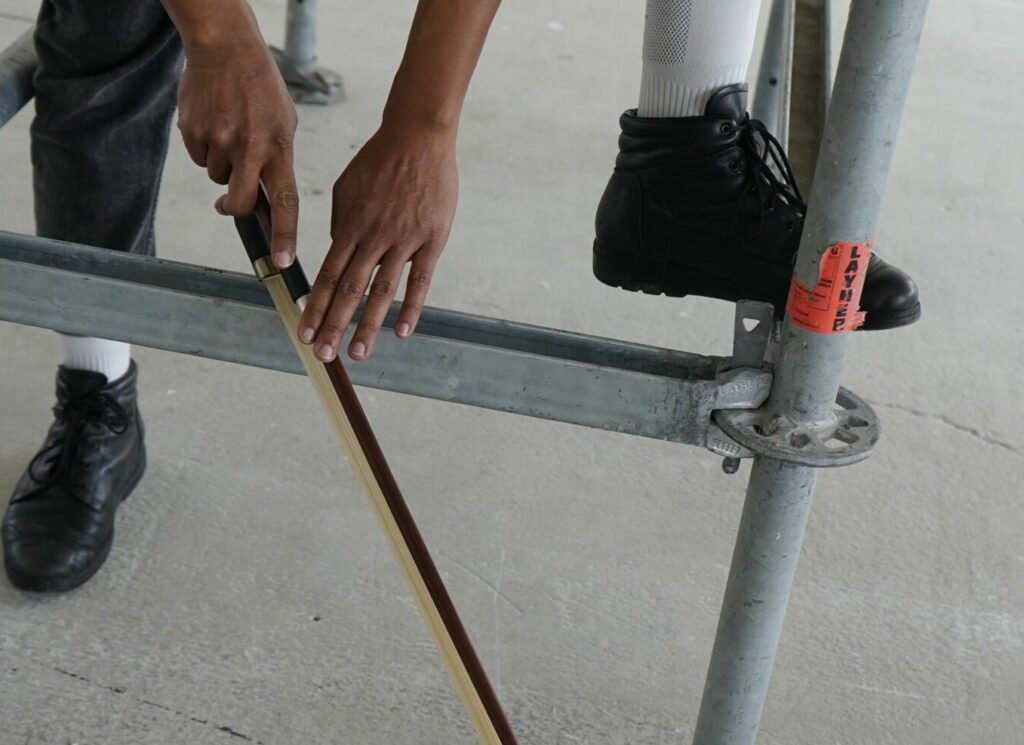Künstlerhaus Stuttgart, Stuttgart, Germany
21 May 2022 - 25 Sep 2022

Photo: Aline Xavier Mineiro, 2022.
The work of Anike Joyce Sadiq consistently reconsiders the extent to which social dynamics, intersectionality, and perspectives of difference are negotiated within institutional structures. Sadiq’s exhibition projects often produce scenographic spaces with installation works that activate a social-situational awareness of the immediate institutional context.
The artist creates mechanisms and platforms for attentiveness to one’s social surroundings, including the people, their interactions, and their behaviors. Sadiq is interested in how interactive, divergent, and converging lived relations specifically play out within sites of artistic production and reception. The scenographic spaces that Sadiq produces contend with fundamental challenges to social connectivity, recognizing for instance that disclosure and exchange are pursued within art institutional structures that too frequently undermine these pursuits. Informing the planning, construction, and use of these spaces Sadiq creates within institutions, the artist at times takes an active mediating role in communications with representatives of the hosting institution and invited collaborators. Sadiq works as an interlocutor, seeking out other interlocutors and inviting in allies, in order to examine dependencies, reciprocities, differences, and hierarchies within the institutions where the artist works. Taking on this high-risk role of internal mediation in producing her exhibition projects, Sadiq employs a position of critical ambivalence that recognizes how institutions intended to be places of public-facing accessibility and facilitation almost always operate internally by deferral and obstruction.
Anike Joyce Sadiq’s first major monographic exhibition in Stuttgart, Mit Glück hat es nichts zu tun, presents newly produced work that carries forward the artist’s investigations into complex social dynamics through mediated spaces that center perceptions of difference. Sadiq’s exhibition at the Künstlerhaus Stuttgart comprises multiple interrelated pieces situated within a large-scale installation. Sadiq wrote a questionnaire addressed to all association members of the Künstlerhaus Stuttgart.[1] The questionnaire itself and the responses to this multiple-choice survey are presented in the exhibition gallery. Additionally, beyond the artist’s exhibition in Stuttgart, the survey and database of survey results will be maintained indefinitely as an openly accessible online platform, with Sadiq distributing the survey to art institutions globally while updating language and other accessibility features to the website as the platform is more widely distributed. While the survey reflects on the status quo and demographics—the racially- specific, gender-specific, class-specific relations—that currently constitute the Künstlerhaus Stuttgart, Sadiq has created a large-scale installation in the gallery that is devoted to generating critically reflexive discussions about the future potential of the institution. Built from a repurposed scaffolding system, Sadiq’s installation emphasizes contingent relations and conditional infrastructure. Focusing on this critical horizon, Sadiq invited a semi-autonomous organization associated with the Künstlerhaus Stuttgart, named the Fourth Organ, to hold their monthly meetings within the large installation. Sadiq has been actively engaged in the Fourth Organ meetings since the organization’s founding in 2020, at the outset of the pandemic and most recent social justice uprising. The Fourth Organ is intended to offer an open, inclusive, interstitial space within the Künstlerhaus Stuttgart, where individuals and groups can voice their interests for the institution. But the Fourth Organ is not solely a space for voicing open proposals or the politics of protest, the monthly meetings are intended to serve a very specific purpose of developing formal motions to be voted on at the annual membership meeting. For Sadiq, the porousness of the Fourth Organ is consistent with her artistic interests in holding space for contentious social dynamics and dissenting positions within art institutions. Because the Fourth Organ meetings are open to board members, staff members, association members, and non-members alike, safety and discretion are challenged by the authority dynamics present in these gatherings. The final work in Sadiq’s exhibition is an interview text the artist conducted with the writer Andrea Scrima that reflects on their experiences working in art institutions, with specific case-study attention given to recent experiences working within the Villa Romana, a German art institution which oversees a residency program in Florence Italy, and which offers related exhibitions and programming. Sadiq’s and Scrima’s incredibly candid first-person account evidences their experiential research into institutional conduct broadly, while also focusing in on the particularly fraught socio-economic conditions of the Villa Romana.[2]
[1] Consistent with the kunstverein structure, the Künstlerhaus Stuttgart is constituted by the legal-economic structures of association law in Germany. The Künstlerhaus Stuttgart currently has over 500 members.
[2] For each work within the exhibition, Sadiq engages in the complex messy work of analyzing, embodying, and enacting institutional structures. The work of institutional analysis and critique is frequently dismissed as being easily adopted and neutralized by the institution in question, but this dismissive characterization of institutional work does not account for the hard fought behind-the-scenes efforts by artists and their collaborators. It must not be forgotten that there are real limitations to confronting institutional structures through artistic positions, with artists’ projects being canceled and collaborating institutional representa- tives having their jobs terminated.